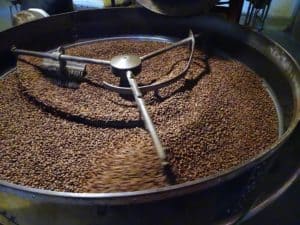 Roasting, in general, is a cooking method that uses dry heat, whether an open flame, oven, or other heat source. Roasting can enhance flavor through caramelization and Maillard browning on the surface of the food.
Roasting, in general, is a cooking method that uses dry heat, whether an open flame, oven, or other heat source. Roasting can enhance flavor through caramelization and Maillard browning on the surface of the food.
Roasting coffee transforms the chemical and physical properties of green coffee beans into roasted coffee products. The roasting process is what produces the characteristic flavor of coffee by causing the green coffee beans to expand and to change in color, taste, smell, and density. Unroasted beans contain similar acids, protein, and caffeine as those that have been roasted, but lack the taste. Heat must be applied for the Maillard and other chemical reactions to occur.
During the roasting process, the coffee beans expand and they will double their size. They also lose around 30 percent of the weight due to the water evaporation.
Coffee brewing can be only done after coffee is roasted and ground. The roasting degree is an important factor for the coffee taste. Along with the grinding size, brewing temperature, and brewing time, roasting degree determines the taste and aroma of the final cup. The main roast flavors are light, medium, and dark. Within these main flavors we can distinguish many roast degrees, simply called roasts. The most important ones are:
- Cinnamon Roast at 196 °C (385 °F)
A very light roast level which is immediately at first crack. Grassy and earthy flavors, and sharp acidity. -
Light Roast at 205 °C (401 °F)
Moderate light brown, but still mottled in appearance. Highlights origin characteristics. -
210 °C (410 °F) American Roast
Medium light brown, developed during first crack. Acidity is slightly muted, but origin character is still fully preserved. -
219 °C (426 °F) City Roast
Medium brown, common for most specialty coffee. Good for tasting origin character, although roast character is noticeable. -
Full City Roast at 225 °C (437 °F)
Medium dark brown with occasional oil sheen. At the beginning of second crack. There are subtle traces of the beans’ origin. -
French Roast at 240 °C (464 °F)
Dark brown, shiny with oil, burnt undertones, very low acidity. At the end of second crack. Dominant roast character. The aroma and flavors of the origin disappear.